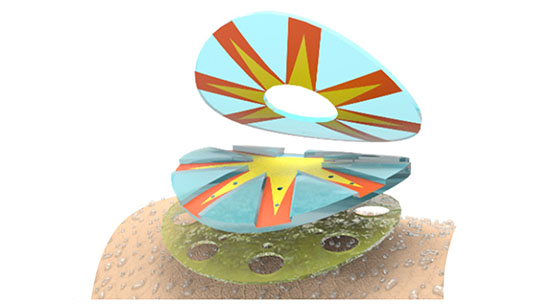
Sweat is an effective body fluid that can be used to analyze bioanalytes without collecting blood. The sweat sensor can relieve the hassle of diabetic patients who repeatedly draw blood, and can also be used in various wearable healthcare devices which monitor the fatigue level of the body and daily health status. However, the practical use of sweat sensors is impeded because the sweat secretion rate is inherently low and irregular. Thus, a new method to collect sweat has been in need.
Recently, a research team led by Professor Cho Kilwon of the Department of Chemical Engineering (CE) and Son Jonghyun (CE Ph.D. Candidate, advisor Prof. Cho Kilwon) developed a skin-attachable patch that quickly and efficiently collects sweat by mimicking the water-collecting principle of cactus spines.
A cactus, which lives in arid environments, survives by attracting water droplets from the tip of its spine to the base. Here, the micro-droplets move due to the difference in pressure between the inside and outside of their curved surface, which is called the Laplace Pressure.
The patch developed by the research team used the principle that cactus spines use to collect water. The research team maximized the difference in Laplace Pressure by optimizing the wedge-shaped wettability patterns with superhydrophobic/superhydrophilic surfaces and the height of the microfluidic channels.
As a result, the wedge-patterned channel can collect sweat quickly and spontaneously regardless of the slope of the microfluidic channel. Therefore, as the patch consisting of wedge-patterned microfluidic channels was combined with a wearable sweat sensor, the response time of the sensor was significantly enhanced, surpassing those obtained using conventional microfluidic channels. Furthermore, by accelerating the circulation rate of sweat in the sensing area, the patch enabled the continuous monitoring of sweat bioanalytes in correlation with their concentration in blood.
Prof. Cho said, “This patch can improve the sweat-collecting capacity, which solves the difficulty of sweat collection in wearable sweat sensors.” He also expressed expectations that “The patch could be combined with various wearable healthcare devices and used for various applications including blood sugar monitoring.”
Meanwhile, the study was selected as the cover paper of Advanced Materials. The study was supported by a grant from the Center for Advanced Soft Electronics under the Global Frontier Research Program and the National Research Foundation of Korea grant funded by the Ministry of Science and ICT of Korea.


